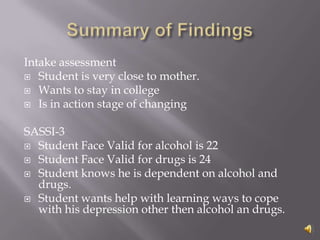Counseling 621
- 1. Case Study
- 2. Blake 21 year old male University of Mississippi Student Junior year Academic Issues Drug and alcohol abuse Diagnosed with ADHD and depression
- 3. Intake Assessment Client demographics Reason for coming Stages of change SASSI-3 Assess drug usage Assess alcohol usage Determine likely hood of dependence
- 4. Intake Assessment Substance Abuse Subtle Screening Inventory (SASSI-3)
- 5. Intake Assessment First Meeting Series of Questions via Paperwork Prochaska and DiClemente stages of change SASSI-3 Series of 86 questions Two face-valid scales 4-point Lickert type scale
- 6. Has been diagnosed with ADHD since 10th grade Diagnosed with Depression since freshman year in college Started abusing drugs freshman year Started abusing alcohol and drugs together sophomore year. Mother is an pharmacist and self medicates him.
- 7. He reported no family psychiatric history. Father and grandfather were alcoholic Has an uncle who is currently on drugs
- 8. Student has an 2.0 overall gpa Freshman year student had 3.0 gpa Sophomore year student had an 2.2 gpa Freshman year student was caught with drug paraphernalia in his dorm room sent to BASIC course. Junior year student received an DUI 1st offense and was sent to JADE course.
- 9. Parents are divorce and he is an only child Student has an apartment off campus Student is apart of a fraternity Drinks at least five beers every night Eats mushrooms and takes oxycotton, ecstasy, and snorts cocaine recreationally Enjoys the party atmosphere of college.
- 10. Intake assessment Student is very close to mother. Wants to stay in college Is in action stage of changing SASSI-3 Student Face Valid for alcohol is 22 Student Face Valid for drugs is 24 Student knows he is dependent on alcohol and drugs. Student wants help with learning ways to cope with his depression other then alcohol an drugs.
- 11. Intake assessment General assessment given to all students that have to take JADE/BASIC SASSI-3 The SASSI-3 has been empirically tested and can identify substance dependence disorder with an overall accuracy of 94%. The SASSI is shown to have good reliability in terms of internal consistency as well as stability over time. The SASSI has been measured countless times and the “Coefficient alpha” results .93 out of an 0-1.00 scale.
- 12. Treatment Plan Monitor his alcohol and drug usage Challenge his negative thinking Refer over to the counseling center Recommendations: Encourage client to seek counseling outside of our facility because we only meet for such a short amount of time.











